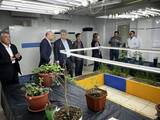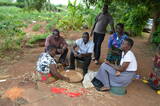News

Background
Water scarcity is one of the greatest challenges of the 21st century, severely impacting agriculture, which accounts for 72 percent of global freshwater withdrawals. Droughts are already a major cause of crop failures in many parts of the world and of acute food insecurity crisis in vulnerable countries. With the...

Increasing salinity conditions is one of the manifestations of climate change which affects agriculture production, food security and nutrition with the potential to lead to environmental degradation. In response, the Global Framework on Water Scarcity in Agriculture (WASAG) works towards collaborative solutions for resilient agrifood systems.
Under the FAO's Value Adding...
AWSAMe initiative: kickoff in Malawi
17/05/2024
17/05/2024

From 13 to 16 May 2024, Malawi hosted a mission in Lilongwe for the ‘Addressing Water Scarcity for Agriculture and Environment’ (AWSAMe) initiative, which includes a component on indigenous, drought resilient and nutritious crops with a potential to improve biodiversity. AWSAMe is a Value Adding Impact Area (VAIA) of ‘Better...
"实现全球农业缺水框架(WASAG)高级别对话 - 技术筹备会议": 在线观看录音
09/04/2024
09/04/2024

缺水是二十一世纪最大的挑战之一,对农业部门来说尤其如此。干旱已经成为世界许多地区农作物歉收和脆弱国家严重粮食不安全危机的主要原因。到 2050 年,世界人口将达到 100 亿左右,我们需要生产比 2012 年多 50%的农粮产品,这将需要至少多 20%的水(提高妇女地位国际运动,2021 年)。不断变化的降雨模式和气候变暖危及全球农民和人民的粮食安全和生计。
海水淡化促进农业发展(DAD)专家咨询研讨会
12/03/2024
12/03/2024

迄今为止,农业是地球可用淡水的最大消耗者:从河道和地下水中抽取的 "蓝水 "有 70% 用于农业用途,并将受到水资源短缺的严重影响。到 2050 年,由于灌溉需要,全球农业用水需求预计将再增加 19%。目前,全球约 40% 的粮食是在灌溉区种植的(Hanjra 等人,2010 年)。
